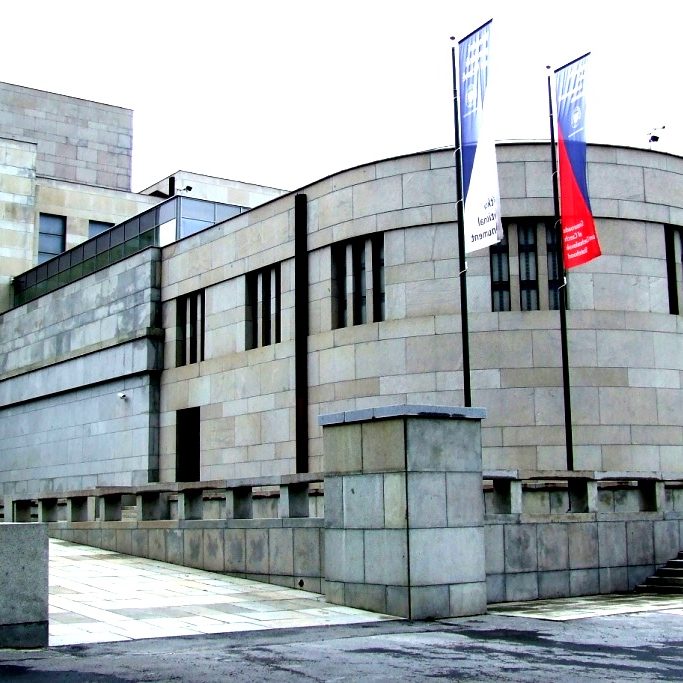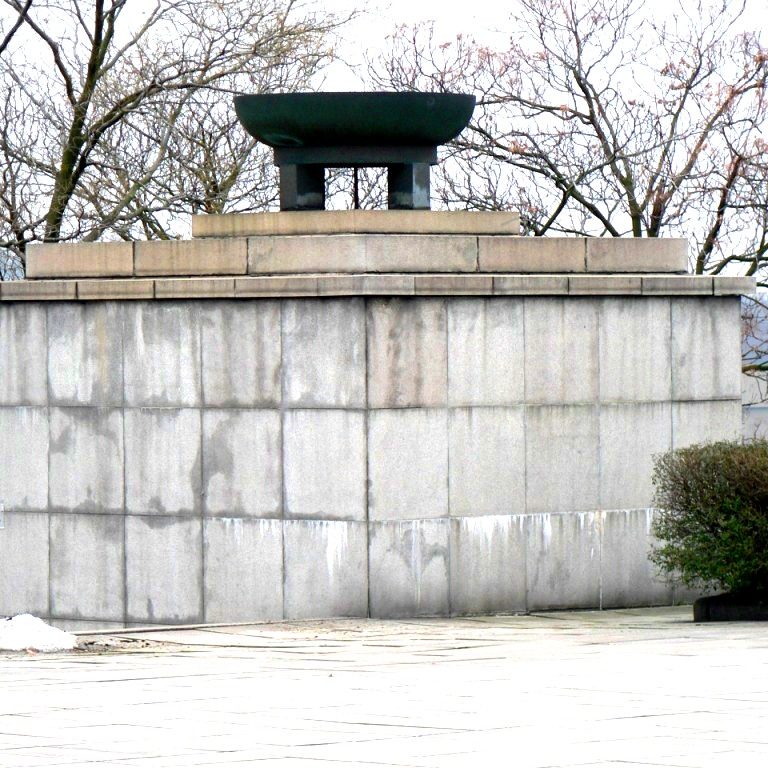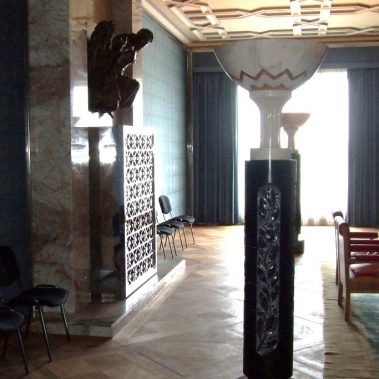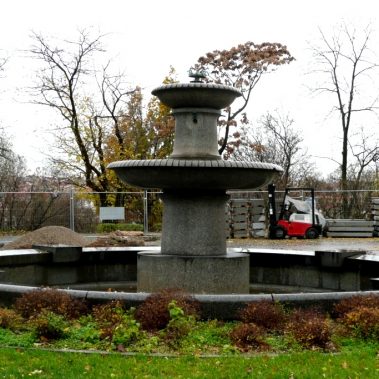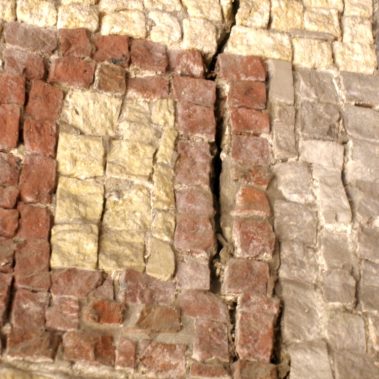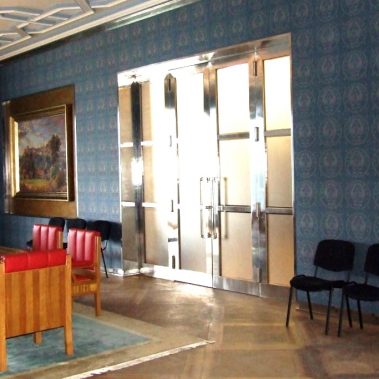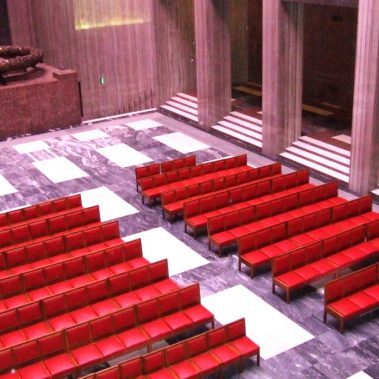National Memorial at Vítkov, Prague - Žižkov, Czech Republic

| Address: | Národní památník Vítkov, U Památníku 1900, 130 00, Praha 3 – Žižkov |
|---|---|
| Description of work: | Exterior building work – treatment and repair of external walls, and drainage of the Courtyard of Honour, underpinning of the foundations, damp- and waterproofing of the lower part of the building
Reconstruction of the interior – installation of inner fire, heat and sound proof doors Restoration work – restoration of the mosaic ornamentation, of doors, windows, floors, ceilings, stone sarcophagi, pictures, electric lighting, stone carving and other stone components of both the interior and exterior |
| Investor: | National Museum |
| Contractor: | GEMA ART GROUP a.s. |
| Implementation: | 05/2007 – 10/2009 |
The history of the National Memorial at Vítkov goes back to 1882, the year of the foundation of the “Society for construction of a Jan Žižka Memorial”, whose task it was to bring into effect the building of the monument. The members of the society organized commemorative events to celebrate the battle of Vítkov in which the Hussite army under the leadership of Jan Žižka of Trocnov defeated a strong German Crusader-led force on July 14th 1420. The society organized three competitions for the design of a statue of Jan Žižka, in 1913, 1923 and 1925. Sculptors Jan Štursa, Jan Kotěra, Jan Mařatka, Ladislav Šaloun and others took place but in the end the society decided to commission the monumental equestrian statue from sketches submitted in 1931 by Bohumil Kafka. The building of the actual memorial commenced on 8th November 1928 when president Tomáš Garrigue Masaryk laid the foundation stone. Apart from commemorating the famous battle, the monument’s other purpose was to serve as a memorial to honour the memory of Czechoslovak legionnaires who perished in the First World War. The remains of an unknown soldier killed in the battle of Zborov in 1917 were also entombed here. The overall responsibility for the project was given to architect Jan Zázvorka and the exterior was finished in 1932, with subsequent additional work on the interior. Nevertheless, the ceremonial inauguration, planned for 28th October 1938, to commemorate the 20th anniversary of the founding of the Czech Republic, could not take place due to a change in political circumstances after the Munich Agreement.
After 1945 a new part was added to the building as a memorial to soldiers killed in World War II. The communist putsch of February 1948 meant an altogether different approach to the whole concept of the memorial and in May 1951 it was decided to turn the Vítkov Hill site into a sort of Pantheon of the proletariat. An additional space was created two years later to accommodate a mausoleum for the newly deceased president Klement Gottwald. In the basement a special laboratory was established where experts monitored the state of the mummified bodily remains of this first Communist president. Despite their efforts the corpse gradually deteriorated and was cremated in 1962. During the Communist era the remains of many party luminaries such as Bohumír Šmeral, Julius Fučík, S. K. Neumann, Bruno Köhler, Drahomír Kolder as well as of presidents Antonín Zápotocký and Ludvík Svoboda were placed in the memorial’s columbarium. At present only the remains of the unknown soldier and since 2006 also those of the general and resistance fighter Alois Eliáš are still placed in the memorial. During the 1990s the complex was mostly used for private functions but this changed when the site came under the administration of the National Museum.
Among the most valuable parts of the memorial are the mosaics in the Hall of the Fallen from the years 1937 and 1938, the work of the artist Max Švabinský, and the bas-reliefs of Czechoslovak legionnaires by sculptors Karel Pokorný, František Bílek and Otakar Velínský in the Central Hall, created between 1936 and 1938. The art of socialist realism can be seen in the Red Army Hall, decorated with mosaics by Vladimír Sychra from 1955, sculptures of soldiers with sub-machine guns at the entrance to the columbarium by O. Kozák, and many others.
The National Memorial at Vítkov has undergone complete reconstruction. The reinforced concrete structure has two levels above ground and a basement. Within the building are several memorial halls and function suites such as the Central Hall, the columbarium, the Hall of the Fallen, the Hall of the Red Army, the Red Hall, the Ceremonial Hall and the presidential salon.
The company GEMA ART GROUP a.s. took a significant part in the complete renovation of the extensive interior spaces of the memorial, constructed mostly from polished limestone, which was overall in a reasonably good shape. More damaged was the panelling of the walls in the Hall of the Fallen. There were cracks caused by dampness, mechanical damage such as chipped corners and other problems. Missing parts were mostly in-filled and restored using polyester-based fillers. Similar damage was also found on the external granite stone panels. As part of the re-enforcement work on the surfaces, this material was treated with a special hydrogenated crude oil preparation.
Further restoration work pertained to the renovation of damaged oak floors and panelling in the presidential salon, and of doors, windows and furniture. Mosaic decorations in the Main Hall, Hall of the Fallen, Hall of the Red Army and Hall of the Traditions have also undergone repair work. Both stone and glass mosaics were in placed cracked, had heavy dirt deposits and pieces missing.
Under the auspices of GEMA ART GROUP a.s. the complete renovation of various stone objects was undertaken: bas-reliefs of soldiers in the Central Hall and in the military columbarium, plaques engraved with lines of poetry in the Hall of the Fallen, the sarcophagi, the granite memorial of the Battle of Vítkov, the Memorial Place of Honour, the State emblem and the foundation stones were all restored. Further restoration work concerned paintings by A. Procházka and V. Beneš and marble sconces in the presidential salon. As well as ceremonial and civic spaces, the entrance halls, staircases, foyers and passageways were all reconstructed.
GEMA ART GROUP a.s. took part in repairs and renovations of the substratum and foundations of the building and their re-enforcement, installation of damp-proofing of the lower portion of the building and drainage and reconstruction of the so-called Courtyard of Honour in front of the memorial. The company was also responsible for other outdoor tasks such as landscape reinforcement, lawn care, reconstruction of the support wall and fencing.
Restoration of stone and ceramic parts:
The most valuable stone sculptures in the interior of the memorial are the marble bas-reliefs of the soldiers from the Czechoslovak Legions from 1936 to 1938 and the two tall argillite bas-reliefs of soldiers with sub-machine guns from 1958 at the corner of the military columbarium. The surfaces of the sculptures were heavily contaminated by dust and covered in old wax but apart from small cracks there was no significant damage. The impurities were removed using a water steam jet and then the repair of small cracks and fissures was carried out. The surface of the stone was consolidated and finally colour retouching and chemical treatment of the stone carried out.
In addition, restoration work was undertaken on the four stone sarcophagi made from black Liptov marble in the columbarium and on the sarcophagus in the Hall of the Red Army made from white Romanian marble. All sarcophagi surfaces were covered with dust deposits and the black sarcophagi were found to have fissures in their sides caused by amateur repairs of the stone in the past. The surfaces of the sarcophagi were cleaned using water and detergent and damaged parts were repaired. Finally, the stone was treated with a silicon based chemical.
Minor restoration work was carried out on the plaque engraved with verses by V. Nezval. The panel itself, made from white Silesian marble, was found to be in good shape. The plaque was cleaned by a water steam jet and treated with a wax preparation. The ceramic tile panelling in the upper part of the Celebration Hall walls also underwent restoration. The ceramics are decorated with emblems of the constituent parts of the first Czechoslovak republic – the Bohemian lion, Moravian eagle, Silesian eagle, Slovakian three hill group with a cross and the Carpathian Ruthenian bear rampant– from 1935. The surface of the ceramics was covered in dust deposits, which were removed using a vacuum cleaner and brushes. Various minor damage and chipped corners were repaired using mineral fillers of a suitable colour.
Some stone elements situated in front of the memorial were also restored: the foundation stones on the north facing slope of the hill, the state emblem, the stone fountain and the memorial of the of the Battle of Vítkov. Surfaces of the stone were covered with a deep layer of dirt and dust deposits, some parts were broken off and some cracked. After cleaning with an aqueous solution containing biocides to remove organic matter, the stone was in-filled and missing parts replaced. Afterwards, the stone was treated with a hydrophobic substance. The official foundation stones, after restoration, were placed among the exhibits. The state emblem from 1997 was the least damaged and was merely cleaned. When restoring the stone structure of the fountain, the stone foundations of its basin were also repaired and its distribution system rebuilt.
Apart from the bas-reliefs and other stone elements, both exterior and interior stone panelling and stone floor tiles were reconstructed. Cracks and other instances of damage were treated by fillers and dirt and other contaminants removed with steam and chemical cleaners. The surfaces were then stabilized.
Restoration of the mosaic decorations:
All figurative mosaic ornamentation in the Main entrance hall, the Hall of the Fallen, the Hall of the Red Army and the Hall of Traditions underwent restoration. The mosaic decorations in the Hall of the Fallen from the years 1937 and 1938 by Max Švabinský is considered to be of the greatest artistic value. The mosaics depict allegories of the Czech Lands from the era of World War I. The mosaics “Song of Freedom” in the Main Hall originate from the same years. Mosaics in the Hall of the Red Army depicting Soviet soldiers were created in the 1950s. The mosaics are made from either glass or stone. All the mosaics were very dirty, most had cracked edges and some pieces were missing. The surfaces were mechanically cleaned, and missing parts replaced using appropriate material. The stone mosaics were treated with an anti-damp agent and dust repellent.
The stone mosaic in the Hall of Traditions from 1961 – 1963, which portrays historic events from the Czech Lands, was in the least satisfactory state. The mosaic was contaminated by dirt and damaged by water leakage. The section depicting peasant uprisings had damage even to its sandstone backing. The whole area was cleaned, in-filled using the same material and treated with anti-damp and anti-pollution agents.
Restoration of furniture:
Restoration concerned mostly the furniture in the Celebration Hall and some other premises. Tables, benches, chairs and armchairs were damaged and cracked and the upholstery torn. The wooden parts were first cleaned, veneers re-attached and damaged areas fixed. Armchairs were re-upholstered in the style of the originals.
Restoration of doors and windows:
Interior doors were showing signs of cracking, surface warping and other material defects. During the work on the doors the wrought iron ornamentation was removed and restored. The doors were sanded, warping treated with under-surface glue, deep grooves in-filled and retouched for colour matching. In some cases the whole doors had to be replaced for reasons of fire resistance, in which case the original wrought iron fittings were transferred to the new doors.
Also restored were the metal doors with twelve bas-reliefs, leading from the upper terrace to the antechamber of the Central Hall. The doors had to be dismantled, cleaned and painted with anticorrosive paint. The doors were then heat-treated using heat insulation technology.
The steel windows of the building were in places in a state of significant disrepair and did not fulfil insulation criteria required for the preservation of valuable exhibits. During the work broken window panes were replaced, window frames re-polished and damaged areas treated.
Repairs of the wooden floors and panelling:
This work pertained mostly to the floor in the presidential salon made of square panels with walnut or oak veneer, which due to water leakage had become partially unstuck. The floor was cracked, worn out, scratched and the surface varnish almost entirely lost. During the work the floor boards were dismantled and loose parts of the veneer glued back with a dispersion wood adhesive. The whole surface was sanded, cracks cleaned and in-filled and finally the wood impregnated with a special oil.
Similar work was carried out on the oak panelling. The whole panelling was dismantled, its components restored and missing parts replaced. The surface was treated with a special oil. The whole process was photographically documented in detail.
Restoration of paintings:
Restoration work concerned two paintings: “National memorial at Žižkov” by A. Procházka and “Tábor” by V. Beneš. The paintings were covered by a layer of dirt and in some areas the paint exhibited signs of mechanical damage and cracking. During the restoration the paintings were mechanically cleaned and small fissures removed using chalk based fillers. Consequently the paintings were retouched using acrylic paints and finally surface coated with Damar varnish with the addition of beeswax.
Restoration of lighting fixtures in the interior:
Stone sconces for light fixtures in the presidential salon, the work of J. Horejc, have also undergone restoration. Black marble body with floral decorations and lighting basins from white marble showed only small damage in the form of fissures. The surface was rid of dust and residual wax deposits by vacuum cleaners and steam and a filler was injected into the fissures. The lighting itself was rewired.
Národní památník na Vítkově nabízí návštěvníkům:
1. Stálé expozice Křižovatky české a československé státnosti a Laboratoř moci.
2. Krátkodobé výstavy.
3. Vyhlídka na střeše památníku (v případě příznivého počasí).
Otevírací doba do interiéru:
listopad – březen: čtvrtek až neděle 10:00 – 18:00
duben – říjen: středa až neděle 10:00 – 18:00
Otevírací doba na vyhlídku:
10: 30 – 17:30
Vstupné:
Stálé expozice: 60 Kč, snížené 30 Kč
Celý objekt: 110 Kč, snížené 60 Kč
Vyhlídka: 80 Kč, snížené 50 Kč
V areálu památníku se pro návštěvníky dále nachází kavárna.









